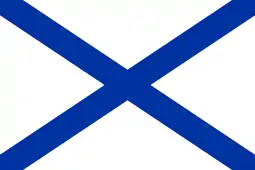Russian Liberation Movement
Russian Liberation Movement (Russian: Русское Освободительное Движение) was a movement within the Soviet Union that sought to create an anti-communist armed force during World War II that would topple the regime of Joseph Stalin. This movement included both Russians and peoples of other nationalities living within the Soviet Union, in which case it is referred to as the Liberation Movement of the Peoples of Russia (Russian: Освободительное Движение Народов России).
History
The movement began spontaneously at the outbreak of the Soviet-German war in June 1941. White Russian emigres, veterans of the White movement, began seeking sympathetic ears in the German Armed Forces (the Wehrmacht) and trying to find a means of creating armed units that would be used on the Eastern Front (such as the Russian Corps). Meanwhile, some captured Soviet officers switched sides, including General Andrey Vlasov. The German propaganda department began exploiting the idea of a Russian Liberation Army (which did not exist) in order to encourage defections, printing up propaganda leaflets encouraging surrender and dropping them in Soviet zones.
The Russian National People's Army, formed in occupied Belarus which was under the command of two White emigres, S.V. Ivanov and Constantine Kromiadi and also had a considerable amount of emigres in its officer core. Later the emigres were replaced by former Soviet commanders B.I. Boyarsky and Georgii Zhilenkov, since Nazi officials dreaded emigre influence on Soviet citizens. The unit, 8,000 men strong, managed to negotiate with Soviet partisans to reduce hostility, displeasing the SS which eventually disarmed the unit. These units were under German supervision, kept to a restricted size (often without being fully outfitted with heavy artillery), and two of them were disarmed out of fear they would not be loyal.
The Russian anti-communist organization National Alliance of Russian Solidarists (NTS) was the only significant organized Russian group that tried to act outside of all German sponsorship. This principle was declared in 1938 by chairman Sergei Baidalakov who said in the wake of the impending military conflict: "With whom do we go? The Russian conscience can have only one answer. Not with Stalin, not with foreign conquerors, but with the entire Russian people." The hope was to create an entirely independent, self-sufficient "third force" that would be anti-Communist and at the same time anti-Nazi, based on a grass roots partisan resistance movement. Shortly before the attack on the Soviet Union, NTS decided to close its offices on Axis occupied territories and go underground in order to avoid Axis infiltration. It also forbade its members to join any German sponsored units, such as the Russian Corps in Serbia.
There was no united center for the movement until the Committee for the Liberation of the Peoples of Russia was founded in November 1944, officially announcing its existence with the Prague Manifesto. This movement, led by General Vlasov, received a surprising groundswell of support amidst white emigres, Soviet Eastern workers, and POWs, despite the apparent futility of the situation (Nazi Germany was already fighting on its own soil when the first Russian liberation units were ready for deployment). The committee received the blessing of Metropolitan Anastasy of the Russian Orthodox Church Outside Russia as well as the Paris Exarchate.
Several armed groups who had been fighting already, such as the Russian Corps of General Boris Shteifon, the "Battle Group" of white General Tourkoul, and the Cossacks of Ataman Helmuth von Pannwitz submitted themselves to the committee's command, although the turn of events prevented them from ever being de facto incorporated into the Russian Liberation Army. Others, such as General Pyotr Krasnov and several Ukrainian armed groups refused to submit to Vlasov and denounced him publicly.
References
- "Разоблачение мифа о "власовском флаге"". Яндекс Дзен | Платформа для авторов, издателей и брендов. Retrieved 2020-05-11.
- Ust-Ilim.info. "Разоблачая фэйки: Российский флаг - это власовский флаг". Телефонный справочник Усть-Илимска (in Russian). Retrieved 2020-05-11.
